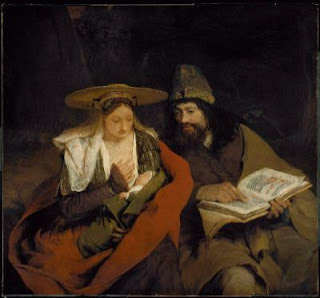The museum itself is undergoing massive construction and renovation, so a number of galleries were closed, to my disappointment. It also has that highly disorienting layout that makes so many art museums so confusing -- gallery leads into gallery, which doubles back onto gallery, and pretty soon, you're going around and around the same statue of Buddha, which is why I tend not to visit the Asian art exhibits. (I DID, however, enjoy the gallery of antique Chinese furniture. Very simple and beautiful.)
Anybody who wants to tour the place can start at the MFA's fantastic website, http://www.mfa.org/index.asp. I have some observations to make that aren't exactly museum-specific.
1. Asia, India, and Indonesia must have produced craptons of "art," because every museum I have ever been in has had rooms and rooms of it. One wonders if there are any votive statues, family altars, antique porcelains, bronze Krishnas, or statues of the Buddha left anywhere in Asia. I think I saw all these same artifacts in Seattle, so I skipped through.
2. Why do middle schools insist on bringing three busloads of seventh graders to museums when I am there? Why, in fact, do they do this at all? The middle schoolers run shrieking through the galleries, waving the lists of questions their teachers have given them, and pooling their answers. They're having a blast, but it's so LOUD.
3. And that leads me to my next question: why are we so hushed and deferential in the presence of Art? It's not like we're going to wake it up or something. Certain pieces have left me speechless, for deeply personal reasons, (Mary Cassatt's "Baby Reaching for an Apple," for instance, and Titian's "Daniel"), but I'm not exactly sure why the middle schoolers shattering the quiet should be considered irreverant. The Appreciation of Art is, apparently, best conducted sotto voce.
4. Finally, where is Sarah and that convenient art history minor when I need her? She's better than a museum guidebook, plus, I can make comments to her that I probably couldn't make to anyone else.

Some of those comments are pretty irreverent. For instance, Theodore van Loon's 1620 "Adoration of the Shepherds," portrays a creepy scene where Mary lifts the blanket off of a blond two year old, so a bunch of people leaning over him can have a closer look. Where do we get these ideas? Then there's Aert de Gelder's "Rest on the Flight into Egypt," above, where Mary appears to be wearing a sombrero. Perhaps she was trying to be incognito? In Antonio de Pereda's "The Immaculate Conception," Mary is standing on a disturbing pile of baby heads. I need to stay out of the 17th Century European galleries.
2 comments:
Ah! I am soooo jealous! And I'm going to run commentary on your comments:
1. Buddhism and Hindu produced massive amounts of art for lots of reasons, the best being that, unlike christianity, you COULD portray their belief system (we have a hard time portraying God, that's why we go for the et. al). You could paint the founder of Buddhism, the Gods of Hindu, no worries. Also, it was worshipful to create these pieces, in absence of congregating at houses of worship (which hit in later in Asian religion) you could meditate right at your own statue. Its kind of like the amount of fertility (we think) goddesses found in neolithic art. Everyone had one! And they could be stylized, there is only so much you could do with a cross in christianity.
Plus: Buddhism and Hindu have been around for a LONG time, these cultures have been around, they have preserved themselves in a way that the egyptians, assyrians, even greeks failed to do. There has not been much change in their religion, and religious art, for millenia. They have had plenty of time to amass their stock.
Another thing (whheeeee a lecture) is that wealth was more evenly spread, for a given amount of spread. More people could afford to stockpile all this art into their tombs, homes, temples. Hence why we have so much. Asian cultures did not melt down their works for the metals for more art, so they kept the pieces around unlike other cultures that were known to recycle.
Okay, now I've gone on so long I've forgotten my other comment.
Oh, got it. The sombrero is a halo. A ridiculously stylized halo that looks stupid. I hate iconographic art. I hate flight into eygpt themes.... I'm actually not a fan of the virgin mary topic at all in art. Any of her story annoys me, it is irrelevant, the Catholics have made her into a main attraction.
Okay, I have more. But I'm done, no one cares much. Tee-hee. I'm so jealous!!! Wish I could be there too!
Wow, that was actually hugely helpful. I really do understand now where all these pieces are coming from.
Unlike you, though, I really do like the virgin in art. Some pieces are incredibly moving. Tell me that the Pieta isn't beautiful and heart-wrenching. (Maybe you'll have to have a son first, but I bet not.) You're right that the deification of Mary has created problems, but the biggest one, I think, is the denial of her humanity. It is in the very reality of her suffering for her son that she becomes meaningful to us.
LY!
Post a Comment